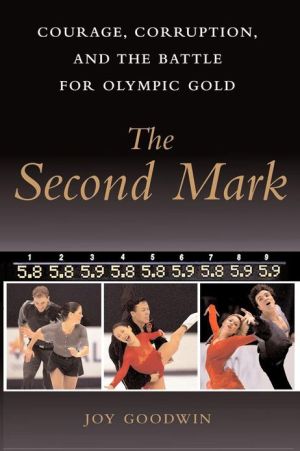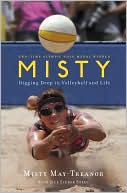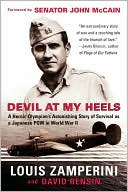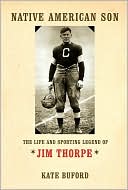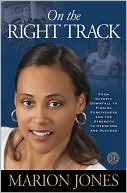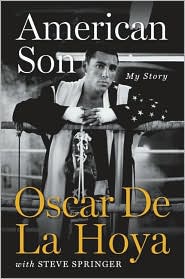The Second Mark: Courage, Corruption, and the Battle for Olympic Gold
It was billed as the greatest event in the history of pair skating: three of the best teams of all time battling for Olympic gold on one night in Salt Lake City. Technical ability was approximately equal. It was the artistic merit score that would decide the gold medal -- the second mark.\ Representing Canada, China, and Russia, the three pairs illuminated their distinct cultures. On the second mark, whose culture would triumph? Would it be the beauty of the Russians' ballet on ice, the...
Search in google:
It was billed as the greatest event in the history of pair skating: three of the best teams of all time battling for Olympic gold on one night in Salt Lake City. Technical ability was approximately equal. It was the artistic merit score that would decide the gold medal -- the second mark.Representing Canada, China, and Russia, the three pairs illuminated their distinct cultures. On the second mark, whose culture would triumph? Would it be the beauty of the Russians' ballet on ice, the thrill of the Chinese pair's heart-stopping acrobatics, or the Canadians' passionate connection with the audience? In a down-to-the-wire nail-biter, the difference between gold and silver came down to the vote of a single judge. Hours later, a bombshell: the confession of a French judge unleashed a worldwide debate -- and ultimately produced an unprecedented duplicate gold medal.The Second Mark reveals what an athlete really goes through to become the best in the world, through the riveting stories of unforgettable people. We meet Yelena Berezhnaya of Russia, who survives emergency brain surgery after a near-fatal training accident and makes it back to the Olympics in less than two years. We meet Zhao Hongbo, a young boy skating in subzero weather in remotest China, who will fulfill his coach's twenty-year dream of catching up to the West. And we meet two Canadians, a barista and a concession stand worker, who had almost quit the sport before deciding to give it one last try -- and becoming world champions.Exhaustively researched by a skating insider, The Second Mark takes readers deep into the world of the Olympic athlete, illuminating the fascinating differences between East and West. From the frozen fields of China to the secret corridors of the old Soviet sports system, from a tiny farm village in remotest Quebec to the judges' backstage world, The Second Mark tells the compelling human stories behind one of the most controversial nights in Olympic history. The New York Times - Christopher Caldwell Goodwin's own romance with pairs skating pays the reader constant rewards. It is not just her attentiveness to the sport's sensual beauty -- the wind skaters create as they pass, the sight of a lithe woman ''flying above her partner's head in a gauzy dress,'' the way you can hear the quality of a skater's technique in the sound of his blades tearing the ice. There is also the empathy she brings to the skaters themselves … The Second Mark can be classed among the rare sportswriting that, with one eye fixed on court or field or rink, manages to tell us something important about the human spirit.
The Second Mark\ Courage, Corruption, and the Battle for Olympic Gold \ \ By Joy Goodwin \ Simon & Schuster\ Copyright © 2004 Joy Goodwin\ All right reserved.\ ISBN: 0-7432-4527-X \ \ \ \ Prologue\ Salt Lake Ice Center February 11, 2002 8:34 PM \ Yelena Berezhnaya places one white skate on the ice, bears down on the narrow blade, and surges forward. Before her the freshly made ice stretches out for two hundred feet. The ice is white, very white, bright as snow under a strong sun, but surprisingly there is no glare. From high at the top of the arena, light filters down in a way that warms the long white expanse and suffuses it with a soft glow. Berezhnaya pushes away from the barrier for the six-minute warm-up, and for a few strange seconds she sees no one ahead of her or beside her and experiences the peculiar sensation of skating alone at the Olympics. Then the other skaters come into view. Here are the Chinese pair and the Canadian couple, and here is her partner, Anton Sikharulidze. With two gliding steps she merges seamlessly into the fast-moving queue of skaters circling the perimeter of the rink.\ From high up in the stands, the brightly costumed skaters circling below look like a school of tropical fish. The arena itself resembles a giant fishbowl. A four-foot barrier encloses the rink. Normally, the first row of spectators would sit just a few feet behind the rink barrier. But in this rink there is a solid wall rising thirty feet above the ice on three sides. This retaining wall has been painted in soothing marine blues and greens, and for the skater down on the ice the sensation is one of being inside a deep bowl whose sides rise up well above your head. Somewhere in the vast space above you, seventeen thousand people are murmuring, fidgeting. Their sounds of anticipation drift down in one large overhead mass of nervous energy. Up in the stands, packed in shoulder-to-shoulder among the Chevrolet dealers and Coca-Cola executives, are more than twenty of the sport's former champions. They are here primarily because the skaters now on the ice represent the greatest collection of talent ever assembled on a single night in pair skating. The Chinese, the Canadians, and the Russians are generally considered to be three of the six best pairs in the sport's hundred-year history, and that is why, for the past three years, experts have been predicting that this Olympic final will be the greatest pairs competition ever. Every past champion, every great coach wanted to be in the building for this one.\ For the moment, however, the world's best pair skaters are pretty much skating forwards and backwards. Within the sport this activity is known as "basic stroking." It is the purest form of skating, and it is the only part of Yelena Berezhnaya's extensive repertoire that she shares with the aristocratic skating enthusiasts who first contested the World Championship on a frozen pond in St. Petersburg in 1896. The simplest movements of skating can be the most difficult to perfect, and few ever achieve absolute mastery over the pure glide. Berezhnaya and Sikharulidze are better at basic stroking than anyone in the world and as good as anyone, ever. Their technique is so singularly exquisite that a few of the former champions up in the stands tonight are looking forward to the first minute of Berezhnaya and Sikharulidze's warm-up more than any other part of the competition. These same past champions will tell you that while they achieved great things in their careers, their one lingering regret is that they could never move over the ice in the way that Berezhnaya and Sikharulidze are moving now.\ Berezhnaya comes flying around a corner, generating a sharp gust of wind. She is wearing a striking short dress of dark pink. Berezhnaya is wearing less clothing to compete in the Olympics than most people sleep in, but she's used to it. Her skirt is lightweight, specially designed to flutter in the breeze created by her speed, thus reminding the judges how fast she is. Berezhnaya's face shows no emotion. She is shy, and no matter what dramatic motions she may make with her body, her expression while skating is always slightly distracted. It is a curious sight to see, as if some cord had become disconnected between her body and her face.\ Berezhnaya carries herself proudly, with the impeccable posture of a prima ballerina. One can almost make out an invisible line running up her spine, which is always pulled taut. Yet her movement is remarkably easy. While keeping the axis of her body perfectly straight, she sways gently to and fro with each stride, in the way that a tent pinned firmly to earth sways softly in a breeze. She holds her arms like wings, raising them slightly with each stroke of the blade, and she is light, light on her feet. Since Berezhnaya is only carrying around ninety-six pounds, which are distributed through her slim five-foot-one-inch frame in the form of pure muscle, it might seem easy enough for her to be light on her feet, but actually size has nothing to do with it. This point is proven when her partner, Anton Sikharulidze, a six-footer weighing a hundred and seventy pounds, passes her with the same perfect, quiet strokes. Their secret is that they have found the elusive sweet spot of the quarter-inch blade and are pressing it into the ice with every step to generate almost pure speed and almost no resistance. They can cover the length of the ice with half a dozen such perfect strides. The result is that relative to anyone else, they appear to waste very little time just skating around. Their two rivals, the Chinese and the Canadians, can't match the Russians' virtuoso stroking, and though the Chinese are undeniably fast, at times their blades make a telltale scratching sound as they score the ice. To the judge's trained ear, that scraping sound is about as welcome as the sound of a phonograph needle being yanked across a record.\ If the Olympic pairs championship were decided on skating forwards and backwards, the Russians would have it in the bag. But twenty minutes hence they will have to make their way through a four-and-a-half-minute program, navigating a minefield of high-risk tricks, any one of which could easily cause a slip. The Russians have never made it through this program in competition without making a mistake, but they will need to tonight. In a competition of this caliber the victory will belong to the team that goes for all the dangerous tricks and hits them all. The program that Berezhnaya and Sikharulidze will attempt tonight would definitely be the most difficult ever attempted in Olympic history, if it weren't for the fact that the Chinese may try an even more difficult program a few minutes later.\ All this makes Tamara Moskvina a very nervous woman. Moskvina has coached Berezhnaya and Sikharulidze from the very beginning of their partnership, but she has never been as nervous for them as she is right now. For that matter she has never been this nervous at any competition in her thirty-year coaching career. At this moment Moskvina is standing right up against the rink boards. She is exceedingly tiny, almost elfin, and she has to stand that close because otherwise she can't see over the four-foot-high barrier. Born in Leningrad a few months before the siege in 1941, Moskvina suffered from wartime hardships like everyone else, and she attributes her short stature to a childhood diet of one hundred grams of bread a day. But Moskvina was never one to dwell on misfortunes, and when she took up pair skating, she found a way to turn her height to her advantage. In Moskvina's youth the so-called one-and-a-half situation, in which a tall man is paired with a much shorter woman, was just a glimmer on the horizon of pair skating, and she formed the female half of one of the earliest such Soviet experimental pairs. (In every one of the twenty pairs competing at this Olympics, the woman is almost a foot shorter than her male partner.) Moskvina was not the most naturally talented pair skater of her generation, but she made up for it in drive. She picked up a national title and a European medal on her way to the 1968 Olympics, where she finished a respectable fifth. Then she stopped competing and took on a few skating pupils. And within twenty years Moskvina became probably the greatest pairs coach the sport has ever seen.\ Moskvina now fixes her skaters with a piercing gaze. For most of the hundreds of hours each year that she coaches Berezhnaya and Sikharulidze, she is out on the ice on skates, chasing after them, shouting at them to go faster, grabbing hold of an arm or leg and lifting it into place. She is surprisingly spry for a sixty-year-old, and often insists on cutting in to demonstrate a move. Six days a week, three hours a day, her instruments are her body and her voice. But in these last, most nervous moments just before a competition, she believes in using her eyes. "I look at them in their eyes," she says. "I hypnotize. I persuade. I guide them to feel how great they are. I do all my tricks." The main problem at such moments is to calm her skaters down without losing the power of that nervous energy, to harness their adrenaline and let it work for them (anticipation) instead of against them (fear).\ In this department, no one in history has more experience than Moskvina. This is the sixth consecutive Olympics at which she has stood beside the rink boards and coached at least one of the top four pairs who comprise the final warm-up group. Over a span of two decades - in Sarajevo, Calgary, Albertville, Lillehammer, Nagano - she has stood almost precisely where she is standing right now, fixing her penetrating gaze on a gold medal contender. Her tricks seem to work. In every case, within the hour, her pair has finished with a brilliant performance and either the gold or silver medal. On two occasions, Moskvina's teams actually won both the gold and silver medals at a single Olympics, a feat that left precisely one bronze medal for the rest of the coaches in the world to fight over. In all, her teams have won three gold and four silver Olympic medals since 1984. If Moskvina's little skating empire constituted a country, it would rank third among nations on the all-time medal count list in Olympic pair skating.\ For all her experience, this moment is pressing in on Tamara Moskvina. She is forcing back the overwhelming sensation that though the competition must happen right here, right now, her team is not ready. For the first time in forty years, the top Russian pair is not coming into the Olympics as the gold medal favorite. Berezhnaya and Sikharulidze have not won the World title since 1999. More to the point, they have lost to the Canadians in their past three meetings, including their most recent showdown six weeks ago in Toronto.\ All this would be alarming enough, but Moskvina is also struggling to rein in a pair that has always been temperamental and unreliable. In their entire career, Berezhnaya and Sikharulidze have never skated what is called "a clean competition," two programs with no mistakes. They invariably make one or more conspicuous mistakes in either the short or the long program. They are prone to odd mishaps, the kinds of things that don't seem to happen to other couples - they tear a costume in the warm-up, miss their bus, forget the ID badges they need to enter the arena. Earlier this week, Berezhnaya stayed too long in a tanning bed and "came home as red as a pig," in the words of Moskvina, who decidedly was not happy. Pair skating relies on touch, and the sunburn was so painful to the touch that the team could not practice for an entire day. It was a beginner's mistake, a mistake that is almost inconceivable for someone at this level of experience, and yet it was typical of this pair. They are brilliant skaters, but they are inconsistent, and they are unlucky. Moskvina feels it in her bones: They are vulnerable. They could lose.\ A loss would be devastating to Moskvina, who has spent her life maintaining the grand tradition of Russian pair skating. A Soviet or Russian team has won the Olympic pairs championship at every Games since 1964, when the legendary Protopopovs first captured the title. Since then, one Russian pair or another has always come through, for ten consecutive Olympics, or Moskvina's entire adult life. Through communism, the fall of communism, the hand-to-mouth transitional years, and the brave new capitalism, Russian pair skating has never wavered. Incredibly, the Russian pairs record is the longest unbroken streak in Olympic history in any sport, summer or winter.\ But for the better part of a year now, insiders have been predicting that the dynasty will end tonight. There is a certain bitter irony in the prospect, since for tonight's performance Moskvina has lifted a signature piece from the Protopopovs' repertoire, Massenet's "Meditation" from ThaÏs. The idea was that the lyrical, elegant music would remind everyone of the unsurpassed beauty of the grand Russian school, and that Berezhnaya and Sikharulidze would join the Protopopovs in history as the latest of the Russian gold medalists. Now it is possible that her team will be reminding everyone of the Protopopovs at the precise moment that they are ending the streak that the Protopopovs began in 1964. Moskvina has done more than any other single person to continue the Russian legacy, but by the end of the night she may find herself at the helm of Russian pair skating at the very moment when the streak comes to an end.\ A few feet to Moskvina's left, the Chinese coach, Yao Bin, watches his skaters speed down the ice side by side, a few feet apart. Their motions are perfectly synchronized. As they approach the end of the rink, the two skaters turn, dig a sharp toe pick deep into the ice, and launch themselves into the air. For a second they are flying, a blur of spinning arms and legs. Then they plummet to earth, each landing on the right foot at precisely the same instant. A roar of approval comes from somewhere above their heads.\ Yao claps briefly, without noticing that he is doing it. He is completely focused on his strategy. He believes that if his team can land the first throw quadruple jump in history, the judges will be compelled to place them first. Yao has an absolutely ferocious competitive streak that he is constantly honing, like a man who draws a knife back and forth, back and forth through a sharpener. Asked to describe her coach, Shen Xue says only one thing: "Mr. Yao likes to win. He really, really likes to win." Yao believes that Shen and her partner, Zhao Hongbo, can win this title outright, and he does not care that most people feel that he should be happy just to be here coaching a gold medal contender when less than twenty years ago, Chinese pair skating was an international joke.\ Yao's path crossed Moskvina's at the 1984 Olympic Games in Sarajevo. Moskvina was there as coach of the eventual gold medalists. Yao and his partner, the first pair skaters ever to represent China, were there to compete.\ \ Continues...\ \ \ \ Excerpted from The Second Mark by Joy Goodwin Copyright © 2004 by Joy Goodwin . Excerpted by permission.\ All rights reserved. No part of this excerpt may be reproduced or reprinted without permission in writing from the publisher.\ Excerpts are provided by Dial-A-Book Inc. solely for the personal use of visitors to this web site. \ \
ContentsNote on Names, Places, and PronunciationProloguePart OneThe PartnersPart TwoThe ArenaEpilogueNotesAcknowledgmentsIndex
\ Bob IvryEven though you might know how the competition ended (with the unprecedented award of two gold medals), you'll bite your fingernails anyway. Goodwin allows you to get to know these folks so well that you don't want to see any of them fail. The story's generous humanity suggests the true Olympic spirit: We root for every team to do its best. We want them all to win.\ — The Washington Post\ \ \ \ \ Christopher CaldwellGoodwin's own romance with pairs skating pays the reader constant rewards. It is not just her attentiveness to the sport's sensual beauty -- the wind skaters create as they pass, the sight of a lithe woman ''flying above her partner's head in a gauzy dress,'' the way you can hear the quality of a skater's technique in the sound of his blades tearing the ice. There is also the empathy she brings to the skaters themselves … The Second Mark can be classed among the rare sportswriting that, with one eye fixed on court or field or rink, manages to tell us something important about the human spirit. \ — The New York Times\ \ \ Library JournalGoodwin has written a fascinating account of the fixed judging of the 2002 Olympic pairs skating event in Salt Lake City. Focusing on the second set of judges' marks (given for artistry), the book outlines the details of the secret trade-off between French and Russian officials to place the Russian pair skaters and the French ice dancers first in their respective events. But this is more than an expose; it is a rich collective biography of all six skaters in the top three competing pairs-from Russia, China, and Canada. Goodwin contrasts their training techniques, home lives, and the deeply different attitudes toward sports in these three nations. Goodwin has obviously interviewed these skaters at great length, and she has communicated with sympathy and drama their personal responses to the life of elite athletic training. The result is a powerful and valuable book about high-profile athletes and how they live their daily lives within very different, and often difficult, circumstances. For all public libraries. [Previewed in Prepub Alert, LJ 11/15/03.]-Bonnie Collier, Yale Law Lib., New Haven, CT Copyright 2004 Reed Business Information.\ \ \ \ \ School Library JournalAdult/High School-Goodwin's book grew out of the judging scandal that marred the 2002 Winter Olympics. Her focus is pair figure skating, and the controversy generated by the scoring of the "second mark," the one awarded for artistic presentation. Using artistry as her starting point, the author traces the careers of the six athletes vying for Olympic gold that year, the Chinese, Russian, and Canadian pairs. Looking at the differing environments that produced these champions, she depicts and contrasts each skater's background, training, and level and type of national support received. She explains how the countries, via their coaches, differed both in their approach to the sport and in their interpretation of artistic expression. Drawing from a year and a half of interviews with the athletes, their families, and coaches, Goodwin presents an honest and intimate portrait of the skaters, describing the physical, emotional, and financial sacrifices made in their quest for Olympic honors. The author is a good storyteller, able to evoke a range of emotions from sympathy and admiration to incredulity and suspense. What will linger long after the reading, however, is her effective personification of "courage" and "corruption" and how the perfidy of several of the adults involved contrasted with the integrity of the young athletes who, under pressure, displayed a grace beyond their years.-Dori DeSpain, Fairfax County Public Library, VA Copyright 2004 Reed Business Information.\ \
